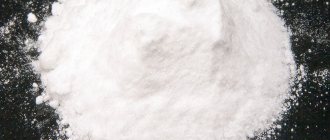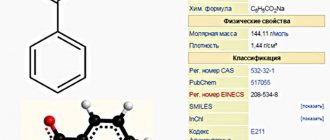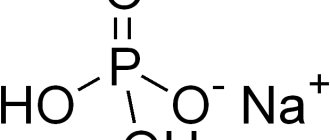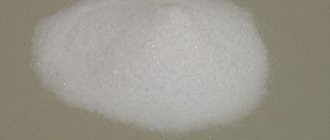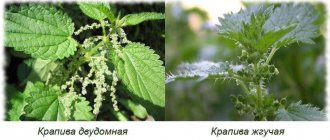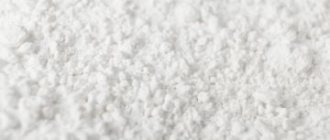Sodium citrate is one of the essential textures in molecular gastronomy and is used in the preparation of agar agar jelly and spherification.
You can buy sodium citrate right now in our store
Sodium citrate is one of the essential textures in molecular gastronomy and is used in the preparation of agar agar jelly and spherification. In the text you will find answers to the following questions:
- what is it - sodium citrate;
- history of use of the substance;
- how the additive is made;
- properties of matter;
- benefits and harms of sodium citrate.
For a snack, let's leave the most delicious thing - a recipe for making chocolate spheres using sodium citrate.
The definition of "sodium citrate" comes from the Latin Natrii citras and literally translates as "sodium salt of citric acid." The additive is also called sodium citrate. The chemical formula of the substance is Na3C6H5o7. Visually, sodium citrate is a white powder. The substance tastes sour and salty.
In the Russian food industry it is listed as a food additive E331.
Sodium citrate was first used in medicine. In 1914, a Belgian doctor, Albert Hastin, and an Argentine research physicist, Louis Egot, used the product as an anticoagulant.
Chemical properties
Sodium Citrate, what is it? To understand what sodium salt of citric acid is, we need to consider its structure. Chemical formula of the substance: Na3C6H5O7. The product has the appearance of a white fine-crystalline powder, has a salty-sour taste, and is odorless. Melts at 310 degrees Celsius. Molecular weight = 258 grams per mole. Tri-substituted Sodium Citrate is highly soluble in water, soluble in alcohols, and insoluble in organic solutions.
Harm and benefit
The chemical compound is actively used:
- as a seasoning, spice, preservative under code E331 , in the production of lemon-flavored soda, energy drinks, gelatin desserts, in baby food;
- as a buffer to maintain a stable pH, as an anticoagulant, in coffee machines;
- in pharmaceuticals, it is part of soluble forms of drugs, for example, for heartburn ;
- as a laxative in the treatment of genitourinary infections;
- in analytical chemistry, when determining ESR;
- in windshield wiper fluids.
Sodium Citrate, as a rule, does not cause harm to the human body. The substance is non-toxic and does not cause irritation upon contact with skin. It is better not to inhale the product. There have been no recorded cases of poisoning with this chemical compound.
Main manufacturers
The domestic market for food sodium citrates is 50% represented by products from Chinese manufacturers. Among them, Anhui Fengyuan Biochemical Co. is the leader. Ltd, which has developed its own highly effective technologies for producing the additive.
More than 1000 tons of E 331 additive per year are produced by the Russian enterprise Citrobel (Belgorod).
A large dose of ammonium acetate can be fatal.
If you see a food additive under the symbol E151 in your favorite product, then you should refuse this delicacy. Why - read here.
Without olives you cannot prepare many delicious dishes. How to choose them correctly, read this article.
special instructions
Treatment courses with Sodium Citrate should not be repeated frequently. If symptoms persist after therapy, it is recommended to change treatment tactics.
It is not recommended to prescribe the medicine to men and children, due to the fact that the disease is often bacterial in nature.
Particular caution is recommended when treating patients with cardiovascular diseases, high blood pressure, kidney disease, diabetes mellitus , and following a salt-free diet.
Effect on the human body
Scientists were able to assess the effect of sodium citrate E331 on humans soon after its discovery. The findings were positive. The substance can even become beneficial to health if used correctly.
Benefit
Citrate takes an active part in metabolism, protects cells from free radicals, and also regulates water and electrolyte balance. Therefore, a person experiences a positive effect from it and even improves health. Benefits of E331:
- prevents blood clotting;
- nourishes cells with energy;
- normalizes stomach acidity;
- eliminates muscle acidification;
- counteracts genitourinary infections;
- restores stool for constipation.
Also, getting the body a moderate amount of sodium hydrogen citrate helps get rid of a hangover. The supplement relieves unpleasant symptoms and normalizes a person’s well-being.
Harm of food additive E331
Sodium citrate is classified as hazard class 3. However, you can only be guaranteed to experience negative effects from its use if you directly inhale the substance. Dangerous citrate can impair breathing, irritate mucous membranes and cause coughing.
When consuming foods, the food additive will be harmful only after exceeding the daily norm. If a person receives more than 1.5 g of citrate, he will experience unpleasant symptoms: nausea, dizziness, diarrhea. Sometimes tachycardia also occurs, blood pressure decreases, and the stomach hurts.
Contraindications for use
You can determine whether a food additive is dangerous or not for a particular person by looking at its contraindications. For example, it is strictly prohibited for those who are intolerant to such a substance. An allergy to E331 can manifest itself with severe symptoms. Also, people with a number of diseases should not consume products with sodium hydrogen citrate. Contraindications for use of E331:
- diabetes;
- stomach ulcer during exacerbation;
- heart or vascular disease;
- disorders of the kidneys.
Also, before using a dietary supplement, you should consult a doctor if you are undergoing drug therapy with potent drugs. Sodium hydrogen citrate is incompatible with many medications. Increased caution should be exercised by pregnant or lactating women whose bodies are weakened.
Drugs containing (Analogs)
Level 4 ATC code matches: Sodium bicarbonate
Trade names of the product: Blemaren , disubstituted Sodium Citrate , Sodium Citrate dihydrate . The substance is contained in the following drugs: Trihydron , Glyugitsir , Gidrovit Forte , Regidron , Faglucid , CFDA-1 , Kafanol , Ionica , Microlax , Re-Sol , Electral .
Dessert recipe using sodium citrate - “Chocolate Spheres” (caviar)
"Chocolate spheres" (caviar)
Ingredients:
- sodium citrate - 0.5 g;
- sugar - 90 g;
- water - 200 g;
- sodium alginate - 3 g;
- calcium lactate - 3 g;
- cocoa powder - 50 g.
Tools:
bowls, pipette, blender
Preparation:
1. Using a blender, mix sodium citrate and sodium alginate in water. 2. Add cocoa powder and sugar. Stir on high speed until smooth. 3. Remove any air bubbles by gently tapping the bowl on the table. 4. Separately prepare a calcium bath. 5. Using a pipette, scoop up the cocoa mixture, drop it into the calcium bath, and leave the caviar for 30 seconds. 6. Using a slotted spoon, remove and rinse in water.
Goes very well with ice cream.
Olfactory impairment in COVID-19: review of drug treatment options
How to restore the sense of smell in patients with COVID-19? The effectiveness of the methods used in world practice. Overview of the prevalence of olfactory impairment in COVID-19. Medicinal and non-medicinal methods in medical practice that restore the sense of smell.
With COVID-19, in addition to general symptoms (cough, fever and fatigue), all countries are reporting an increase in the number of patients with loss of smell and taste. Changes in odor perception were previously noted in other viral infections (parainfluenza, rhinovirus, SARS, etc.), but with a much lower frequency than in those infected with SARS-CoV-2. The pathophysiology of post-infectious loss of smell is currently being considered in numerous domestic and foreign reviews.
The question of how to restore the sense of smell is quite acute, since throughout the world the number of people with coronavirus infection COVID-19, and therefore with this symptom, is increasing every day. The fact is that olfactory dysfunction affects the quality of life. People with loss of smell face problems when preparing food and determining its freshness. Eating behavior often changes - there is a decrease in appetite up to indifference to food. Olfactory dysfunction is associated with multiple comorbidities, including depression, cognitive impairment, and poor nutrition. Restoring the sense of smell is also necessary to warn about dangers in everyday life: the smells of gas, smoke, burning, acids, alkalis and alcohols are often the first signal that allows a person to save life and health. [1-3]
Terminology applicable to changes in smell:
- Normosmia – normal sense of smell.
- Hyposmia (or microsmia) is a decrease in the sensitivity of smell.
- Anosmia is a complete loss of smell.
- Hyperosmia is increased sensitivity to ordinary odors.
Identity disorders (dysosmia):
- Parosmia is a substitution of odor identification (perceived as the odor of another object).
- Phantosmia is the perception of smell in the absence of actual smell (olfactory hallucination).
- Cacosmia is a feeling of absent unpleasant odor (a special case of parosmia/phantosmia) or increased sensitivity to a certain unpleasant odor (selective hyperosmia).
Prevalence of smell impairment in COVID-19
On November 20, 2022, Jeyasakthy Saniasiaya and Md Asiful Islam published a meta-analysis of 27,492 patients, “Prevalence of olfactory dysfunction in coronavirus disease 2022 (COVID? 19).”
Overall, the prevalence of this symptom in patients with COVID-19 was 47.85%. From subgroup analysis, olfactory dysfunction was identified in 54.40% of European, 51.11% of North American, 31.39% of Asian and 10.71% of Australian patients with COVID-19. Additionally, anosmia, hyposmia, and dysosmia were observed in 35.39%, 36.15%, and 2.53% of COVID-19 patients, respectively. Interestingly, olfactory dysfunction was higher in non-severe patients compared to severe COVID-19 patients (47.48% vs 9.02%).[4]
Review of treatment options with recommendations
In August 2022, Hura N, Xie DX, Choby GW published a scientifically based review with recommendations “Treatment of post-viral olfactory dysfunction” [5], summarizing the data on the advisability of using various means that restore the sense of smell. Recommendation grades included cumulative grade of evidence (A to D). The purpose of the recommendations was to weigh the quality of the study against the potential balance of benefits and harms of smell loss.
Systemic steroids (prednisolone, methylprednisolone, betamethasone)
Six studies have been conducted to restore the sense of smell using systemic steroids. The duration of observation, olfactory testing, and systemic steroid dosing varied widely. Overall, 4 studies showed modest benefit from systemic steroids [6-9], while the design of other studies did not allow definitive conclusions about the ability to restore smell with this category of drugs. [10,11]
Summary:
- Cumulative evidence: C.
- Benefit: Objective improvement in the sense of smell based on several psychophysical tests.
- Harm: Possible side effects associated with systemic corticosteroids.
- Cost: low.
- Assessing benefits and harms: balance of benefits and harms
- Evaluative Opinion: The physician should consider the risk of systemic corticosteroids in the presence of comorbidities in patients.
- Recommendation level: possible. In the absence of additional risk factors, it may be possible to suggest a short course of systemic therapy to restore the sense of smell, after careful consideration of the potential benefits and risks associated with treatment.
Topical steroids
Four studies assessed the effect of topical corticosteroids, including fluticasone propionate, beclomethasone spray, and dexamethasone or betamethasone injections, as olfactory restorers. [12-15]
- Cumulative evidence: C
- Benefit: Improved TDI scores (odor threshold (T), discrimination (D), and identification (I) test scores)
- Harm: Minimal treatment-related side effects (eg, local irritation, possible nosebleeds).
- Cost : low.
- Assessing benefits and harms: balance of benefits and harms
- Opinion: Inhomogeneous studies make it difficult to make recommendations based on the minimum likely benefit combined with the minimum harm.
- Recommendation level: possible. Low-risk therapy with potential improvement in sense of smell but low potential benefit. It can be offered to patients in order to restore their sense of smell, but if there is no improvement effect at the start of therapy, it is rather inappropriate for long-term use.
Non-steroidal local drugs
Three studies examined intranasal sodium citrate for loss of smell. Additionally, one identified study compared intranasal insulin with saline placebo. [16-18] But since this is a single pilot study, there is not enough evidence to include it in a valid summary.
Intranasal sodium citrate
- Cumulative evidence: B
- Benefit: Short-term and temporary improvement in objective olfactory sensations after treatment.
- Harm: Minimal, including transient rhinorrhea, sore throat and nasal congestion.
- Cost: minimal
- Assessing benefits and harms: balance of benefits and harms
- Opinion: The level of evidence from these studies shows promise for intranasal sodium citrate in patients seeking olfactory restoration, but the variable nature and short-term follow-up make it difficult to determine the effectiveness of long-term clinical use of sodium citrate.
- Recommendation level: possible. A low-risk therapy with demonstrated temporary improvement in the sense of smell, but the long-term effectiveness of sodium citrate as a smell-restoring agent is unclear.
Non-steroidal oral drugs
Oral agents have also been studied as drugs that restore the sense of smell: antibiotics, vitamin A, alpha-lipoic acid. This group is characterized by low quality of clinical studies. Zinc sulfate has 3 studies with the best design - it has a separate conclusion, although it did not find significant effectiveness in restoring the sense of smell in patients receiving zinc sulfate in different regimens. [19-21]
Antibiotics. Two studies assessed the ability of different antibiotics to restore the sense of smell. In the first, there was no difference in TDI between the minocycline group and the placebo group. The second found no overall improvement in odor identification scores after treatment, but patients with smell loss improved odor detection thresholds after treatment. [22-23]
Vitamin A has also not shown consistent results when used to restore the sense of smell. Duncan et al. in 1962 reported improvement in subjective olfactory function. In a double-blind, randomized, placebo-controlled study, Reden et al. compared the effectiveness of 10,000 IU vitamin A per day for 3 months with placebo. While TDI scores increased significantly in all patients, there was no significant difference between the placebo and vitamin A groups.[24,25]
Alpha lipoic acid, commonly used to treat diabetic neuropathy, was studied by Hummel et al. as a means of restoring the sense of smell. TDI improved after 4.5 months of alpha lipoic acid 600 mg/day but did not reach the minimal clinically important difference.[26]
Oral antibiotics, vitamin A, alpha lipoic acid.
- Cumulative evidence: D
- Benefit: Improved TDI scores, subjective assessments.
- Harm: Minimal drug side effects have been reported, but they were not strictly assessed in all studies.
- Cost: minimal to moderate.
- Assessing benefits and harms: balance of benefits and harms
- Evaluative opinion: a set of studies of different drugs performed to varying degrees of quality
- Level of recommendation: not recommended for use to restore the sense of smell.
Oral zinc sulfate
- Cumulative evidence: B
- Benefit: There are no studies demonstrating restoration of the sense of smell as a result of use
- Harm: There are no risks associated with therapy, although zinc toxicity is possible.
- Cost: moderate.
- Benefit-harm assessment: the preponderance of harm over benefit.
- Rating opinion: no
- Level of recommendation: not recommended as a means of restoring the sense of smell.
Olfactory training
Olfactory training refers to methods that allow you to restore your sense of smell without additional drug load on the patient’s body. Only ten studies assessed the effectiveness of olfactory training. [26-35]. Most studies used a protocol involving exposure to four odors twice daily for at least 12 weeks.
In 4 studies comparing olfactory training to no treatment, olfactory training was found to produce statistically better results and return of smell. [27,29,32,33]. The researchers also concluded that long-term training was superior to short-term training, with a significantly higher average TDI score after 56 weeks, although both groups showed the greatest improvement in their sense of smell during the first 16 weeks. [33] Interestingly, the shorter the duration of smell loss before treatment, the greater the effect of smell-restoring procedures. Damm et al. demonstrated a greater effect of olfactory training with high-concentration odors compared with low-concentration odors in patients with a duration of VOPD less than 12 months. [thirty]
Poletti et al. conducted a prospective pseudo-randomized study in which patients were trained using low molecular weight (<150 g/mol) or high molecular weight (>150 g/mol) odorants to regain their sense of smell. In this study, they concluded that high molecular weight odorants exceed threshold values compared to low molecular weight odorants in patients with smell loss.
Practical issues of olfactory training
For use in olfactory training, essential oils are the simplest and most effective. Essential oils have a high molecular weight and a complex chemical composition: they contain two or three main components, mainly terpenes, terpenoids and phenylpropanoids.
When choosing an essential oil to use to restore your sense of smell, it is important to pay attention to the quality of the product. There are a large number of surrogate essential oils on sale, which are vegetable oils with a small percentage of essential oil (the condition of high odor concentration is violated) or an artificial flavor with a low molecular weight, which will not be sufficiently effective and will not help restore the sense of smell.
The issue of training compliance is also open - loss of smell and other disturbances in the perception of smells during COVID-19 continue after the end of isolation of patients, and training with the use of 4 odors in some patients, due to employment and lifestyle, often causes difficulties, despite the desire to regain the sense of smell.
An alternative solution that can be easily implemented on the road or at work is to use one mixture of essential oils. In Russia, “Breathe Oil” is presented (JSC Akvion), which consists 100% only of essential oils. The dominant aromas in the composition are mint and eucalyptus, which allows you to concentrate on identifying these two aromas in turn during training sessions that restore your sense of smell, when it is impossible to conduct a full-fledged training session with 4 oils.
A distinctive feature of “Breathe Oil” is a high standard of quality and safety: the product is used for the prevention in complex therapy of respiratory infections and rhinitis in children; more than 11 clinical studies have been conducted on it (more details: https://clck.ru/SZWdc), which confirmed the high safety profile and effectiveness. The supplier of raw materials is the German company Freu&Lau with a European level of quality control. To increase compliance, there is a form in the form of a patch on clothes, a bracelet on the arm, a spray and oil with a dispenser. https://clck.ru/SUpek
Olfactory training
- Cumulative evidence: B
- Benefit: Improved performance on objective tests (UPSIT, Sniffin' Sticks).
- Harm: minimal, inconvenience of daily training.
- Cost: minimal.
- Assessment of benefits and harms: the preponderance of benefits over harm.
- Opinion: Given that it is a low-cost option with minimal to no harm and proven benefit, the value of this olfactory-restoring method is high.
- Recommendation Level: Recommended! Initiate olfactory training as soon as the patient is diagnosed with loss of smell or other olfactory dysfunction.
Overall, olfactory training was found to improve olfactory function in all 10 studies. It has been found that higher concentrations and molecular weights of odors, longer durations of olfactory training, and different odors used for them help restore the sense of smell more effectively. The shorter the time interval between the onset of smell disturbances and the start of training, the better the results of the procedures. As an alternative, if patients with loss of smell are refusing comprehensive training, you can consider using Breathe Oil. In addition to olfactory training, health care providers may suggest a course of systemic or topical steroids to restore the sense of smell after assessing the risks.
- Temmel AF, Quint C, Schickinger-Fischer B, Klimek L, Stoller E, Hummel T. Characteristics of olfactory disorders in relation to major causes of olfactory loss. Arch Otolaryngol Head Neck Surg. 2002;128(6):635-41.
- Kollndorfer K, Reichert JL, Bruckler B, Hinterleitner V, Schopf V. Self-esteem as an important factor in quality of life and depressive symptoms in anosmia: A pilot study. Clin Otolaryngol. 2017;42(6): 1229-34.
- Boesveldt S, Postma EM, Boak D, Welge-Luessen A, Schopf V, Mainland JD, et al. Anosmia-A Clinical Review. Chem Senses. 2017;42(7):513-23.
- Saniasiaya J, Islam MA, Abdullah B. Prevalence of Olfactory Dysfunction in Coronavirus Disease 2022 (COVID-19): A Meta-analysis of 27,492 Patients. Laryngoscope. 2022 Nov 20.
- Hura N, Xie DX, Choby GW, et al. Treatment of post-viral olfactory dysfunction: an evidence-based review with recommendations. Int Forum Allergy Rhinol. 2020;10(9):1065-1086.
- Seo BS, Lee HJ, Mo JH, et al. Treatment of postviral olfactory loss with glucocorticoids, Ginkgo biloba, and mometasone nasal spray. Arch Otolaryngol? Head Neck Surg. 2009;135(10):1000-1004.
- Kim DH, Kim SW, Hwang SH, et al. Prognosis of olfactory dysfunction according to etiology and timing of treatment. Otolaryngol? Head Neck Surg (United States). 2017;156(2):371-377.
- Schriever VA, Merkonidis C, Gupta N, et al. Treatment of smell loss with systemic methylprednisolone. Rhinology. 2012;50(3):284-289.
- Heilmann S, Huettenbrink KB, Hummel T. Local and systemic administration of corticosteroids in the treatment of olfactory loss. Am J Rhinol. 2004;18(1):29-33.
- Stenner M, Vent J, Hüttenbrink KB, et al. Topical therapy in anosmia: relevance of steroid-responsiveness. Laryngoscope. 2008;118(9):1681-1686.
- Ikeda K, Sakurada T, Suzaki Y, Takasaka T. Efficacy of systemic corticosteroid treatment for anosmia with nasal and paranasal sinus disease. Rhinology. 1995;33(3):162-165.
- Mori J, Aiba T, Sugiura M, et al. Clinical study of olfactory disturbance. Acta Otolaryngol Suppl. 1998;538:197?201.
- Blomqvist EH, Lundblad L, Bergstedt H, Stjarne P. Placebo-controlled, randomized, double-blind study evaluating the efficacy of fluticasone propionate nasal spray for the treatment of patients with hyposmia/anosmia. Acta Otolaryngol. 2003;123(7):862-868.
- Fukazawa K. A local steroid injection method for olfactory loss due to upper respiratory infection. Chem Senses. 2005;30(suppl 1):212-213.
- Fleiner F, Goktas O. Topical beclomethasone in the therapy of smelling disorders—a new application technique. Indian J Otolaryngol Head Neck Surg. 2011;63(1):5-9.
- Philpott CM, Erskine SE, Clark A, et al. A randomized controlled trial of sodium citrate spray for non-conductive olfactory disorders. Clin Otolaryngol. 2017;42(6):1295-1302.
- Whitcroft KL, Merkonidis C, Cuevas M, et al. Intranasal sodium citrate solution improves olfaction in post-viral hyposmia. Rhinology. 2016;54(4):368-374.
- Whitcroft KL, Ezzat M, Cuevas M, et al. The effect of intranasal sodium citrate on olfaction in post-infectious loss: results from a prospective, placebo-controlled trial in 49 patients. Clin Otolaryngol. 2017;42(3):557-563.
- Henkin RI, Schecter PJ, Friedewald WT, et al. A double blind study of the effects of zinc sulfate on taste and smell dysfunction. Am J Med Sci. 1976;272(3):285-299.
- Aiba T, Sugiura M, Mori J, et al. Effect of zinc sulfate on sensorineural olfactory disorder. Acta Otolaryngol. 1998;118(538):202-204.
- Quint C, Temmel AFP, Hummel T, Ehrenberger K. The quinoxaline derivative caroverine in the treatment of sensorineural smell disorders: a proof-of-concept study. Acta Otolaryngol. 2002;122(8):877-881.
- Reden J, Herting B, Lill K, et al. Treatment of postinfectious olfactory disorders with minocycline: a double-blind, placebo-controlled study. Laryngoscope. 2011;121(3):679-682.
- Wang JJ, Chen J, Doty RL. Impact of antibiotics on smell dysfunction. World J Otorhinolaryngol? Head Neck Surg. 2018;4(1):33-38.
- Duncan RB, Briggs M. Treatment of uncomplicated anosmia by vitamin A. Arch Otolaryngol. 1962;75(2):116-124.
- Reden J, Lill K, Zahnert T, et al. Olfactory function in patients with postinfectious and posttraumatic smell before disorders and after treatment with vitamin A: a double-blind, placebo-controlled, randomized clinical trial. Laryngoscope. 2012;122(9):1906-1909.
- Hummel T, Heilmann S, Hüttenbriuk KB. Lipoic acid in the treatment of smell dysfunction following viral infection of the upper respiratory tract. Laryngoscope. 2002;112(11):2076-2080.
- Hummel T, Rissom K, Reden J, et al. Effects of olfactory training in patients with olfactory loss. Laryngoscope. 2009;119(3):496-499.
- Fleiner F, Lau L, Ö Göktas. Active olfactory training for the treatment of smelling disorders. Ear Nose Throat J 2012;91(5):198-215.
- Konstantinidis I, Tsakiropoulou E, Bekiaridou P, et al. Use of olfactory training in post-traumatic and postinfectious olfactory dysfunction. Laryngoscope. 2013;123(12):85-90.
- Damm M, Pikart LK, Reimann H, et al. Olfactory training is helpful in postinfectious olfactory loss: a randomized, controlled, multicenter study. Laryngoscope. 2014;124(4):826-831.
- Geißler K, Reimann H, Gudziol H, et al. Olfactory training for patients with olfactory loss after upper respiratory tract infections. Eur Arch Oto-Rhino-Laryngology. 2014;271(6):1557-1562.
- Altundag A, Cayonu M, Kayabasoglu G, et al. Modified olfactory training in patients with postinfectious olfactory loss. Laryngoscope. 2015;125(8):1763-1766.
- Konstantinidis I, Tsakiropoulou E, Constantinidis J. Long term effects of olfactory training in patients with post-infectious olfactory loss. Rhinology. 2016;54(2):170-175.
- Poletti SC, Michel E, Hummel T. Olfactory training using heavy and light weight molecule odors. Perception. 2017;46(3?4):343-351.
- Nguyen TP, Patel ZM. Budesonide irrigation with olfactory training improves outcomes compared with olfactory training alone in patients with olfactory loss. Int Forum Allergy Rhinol. 2018;8(9):977-981.
How can I replace E331?
Manufacturers of canned fish and meat replace sodium citrate with triphosphates (E451) or orthophosphoric acid (E452). The first substance regulates acidity and acts as an emulsifier, the second increases the shelf life of products.
Pyrophosphates (E450) are added to minced meat and canned food so that they remain fresh longer.
E339 is often added to milk, butter, and bread to preserve the properties of the product. An analogue of E331 is sodium carbonate, which is considered a preservative for meat products.
Additive E451.
Interesting Facts
There are several interesting facts associated with the dietary supplement:
- It is resistant to high temperatures, therefore it is used for the manufacture of dairy products that require long-term heat treatment.
- Constant consumption of foods with sour salt leads to disruption of the taste receptors. People consider artificial food more appetizing than natural food.
- The substance is used in alpine skiing. Skiers receive it before the descent to avoid muscle acidification.
Acid salt is used in molecular gastronomy. It is necessary for chefs to create sphere-shaped desserts, as it helps maintain the unusual shape.
Application
Sodium citrate E331 is widely used in the food industry. In the production of processed cheese as a melting salt in an amount of up to 30 g/kg of processed cheese. Citrates give processed cheese a pleasant, slightly sour taste and a moderately dense, elastic consistency. A decrease in pH creates unfavorable conditions for the life of gas-forming microorganisms, as a result of which processed cheese using citrates is more stable during storage.
As a stabilizer for minced meat products up to 3 g/kg of meat or fat. To restore the salt (ionic) balance necessary for the thermal stability of milk subjected to heating, stabilizer salts are added to it, which can be all citrates that bind calcium ions. Salts are used in the form of 10-25% aqueous solutions. Tri-substituted sodium citrate most effectively restores salt balance. The dose of stabilizer salt depends on the heat resistance of a particular batch of milk, therefore it ranges from 0.05-04% of the mass of the mixture being normalized.
Sodium citrate E331 is also used as an acidity regulator and retarder in marmalade, jams, preserves, pectin jellies, desserts, bakery, confectionery products, etc. up to 10 g/kg; antioxidant synergist in juices, margarines, vegetable oils, lard, pork fat 100 mg/kg. Acceleration of the dissolution of dry mixtures (for example, for ice cream) is achieved by adding phosphates or sodium citrates.
Sodium citrate
trisubstituted is included in the list of raw materials for margarine; canned milk; cocoa with condensed milk and sugar; sterilized condensed milk; whole condensed milk.
